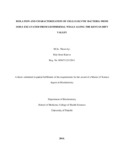| dc.description.abstract | Cellulolytic microorganisms such as fungi and bacteria are responsible for much of the cellulose
degradation in soils. Despite this vast number of cellulase producers, there is a deficiency of
microorganisms that can produce significant amount of the three cellulase enzyme specifities i.e.
endoglucanases, exoglucanases and cellobiases to efficiently degrade cellulose to fermentable
products. Little emphasis has been given to cellulase production from bacteria despite their
extremely high natural diversity, which endows them with the capability to produce stable
enzymes.
Soil samples were collected from Hell’s gate and from a geothermal well in Eburru hill at depths
of 155 Metres, 156 Metres and 157 Metres in the Kenyan Rift valley. The soil samples were
inoculated separately and from each, only a single bacterial isolate was obtained. The four
isolates were screened for cellulolytic activity using Congo red stain on Carboxymethylcellulose
(CMC) agar plates inoculated with the isolates. All the isolates were found to hydrolyze
Carboxymethylcellulose.
A Gram stain test carried out identified the four isolates as Gram-positive rods. Phylogenetic
analysis indicated that they all associated mainly with members of the Bacillus licheniformis.
Eburru 156 isolate (Isolate 3) selected for further functional studies bore the three enzyme
specificities of a cellulase enzyme system. A crude enzyme extract was found to hydrolyse
Cellobiose, Avicel and CMC with enzyme activities of 0.46878U/mg, 0.18784U/mg and
0.13571U/mg respectively. Optimum temperature for activity measured over 60 minutes was
found to be 60oC with relatively high activity at both 70oC and 80oC. The optimum pH at the
predetermined optimum temperature was found to be pH 5. This thermotolerance in addition to
production of the three cellulase enzyme activities makes the isolate attractive for potential
application in the biorefinery industry. | en_US |

